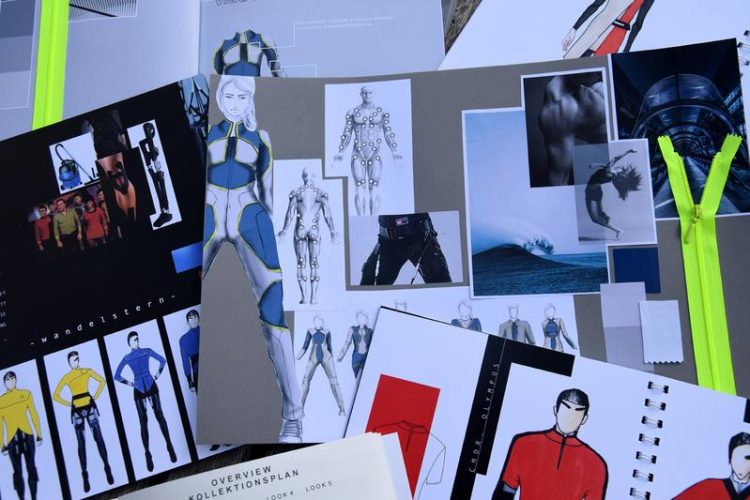Progress through research

In the design competition "Spacetex 2030", students are designing station wear for long-term missions in outer space, such as the proposed flight to Mars in 2030. ©Hohenstein Institute
The motto for the Hohenstein Institute's stand at the Techtextil show in Frankfurt/Main from 4 to 7 May 2015 will be “Progress through research”.
One of the main features displayed at stand 3.1 B21 will be the artificial uterus “ARTUS. Another research highlight will be the results of a large-scale survey of 3D head shapes. The “Spacetex 2030” design competition and the new OEKO-TEX® certifications “STeP” and “Made in Green” will also be featured.
ARTUS
With the ARTificial UteruS “ARTUS”, the experts at the Hohenstein Institute have developed the world's first system for helping premature babies to develop by providing sensory stimulation.
As part of a research project (ZIM project KF2136730KJ3), the scientists at Hohenstein have developed an initial prototype which will be on display on their stand at the show. It is used inside an incubator, where acoustic stimuli like the mother's heartbeat and voice are transmitted to the premature baby, together with mechanical sensations like the gentle rocking experienced in the mother's body.
3D head shape survey
Researchers at the Hohenstein Institute spent about two years measuring the heads of 6000 men, women and children, and thoroughly examining their shapes and dimensions. With the help of more than 40 defined measuring points, they analysed the circumference, width and length of the head and many other important dimensions, and evaluated them statistically. In a research project (IGF project 16976 N / 1), they succeeded in developing a new sizing chart specifically for heads, and for the first time defined characteristic 3D head shapes.
“Spacetex 2030” design competition for students
What particular kinds of functionality does clothing for astronauts have to offer, especially in the light of long-term missions? This is the question to be answered by students in the “Spacetex 2030” design competition by producing creative and practical designs. At the Techtextil show, the Hohenstein Institute will be presenting a selection of the entries, and some of the first that have been actually created.
The competition is building on the current research project, “Spacetex”. This is being carried out jointly by the Hohenstein Institute (Bönnigheim – Germany), © Schoeller Textil AG (Sevelen – Switzerland), Charité (Berlin – Germany) and DLR (Bonn/Bremen – Germany). The aim of the project is to obtain data about the interaction of body, clothing and climate in zero gravitation.
This data will later be used to optimise textile materials in the light of the special conditions of weightlessness, but also for extreme climatic conditions on Earth.
STeP and Made in Green by OEKO-TEX®
STeP (Sustainable Textile Production) is the OEKO-TEX® certification system for brands, retail companies and manufacturers in the textile chain who want to communicate their achievements regarding sustainable production to the public in a transparent, credible and clear manner. Certification is possible for production facilities at all processing stages, from fibre production, spinning mills, weaving mills and knitting mills to finishing facilities and manufacturers of ready-made textile items.
With the product label “Made in Green by OEKO-TEX®”, the OEKO-TEX® Association based in Switzerland is introducing a new certificate for textiles that have been proven not to be harmful to health and are also produced in sustainable and socially responsible conditions. The label replaces the previous certification systems under the OEKO-TEX® Standard 100plus and the Spanish quality mark “Made in Green by Aitex”. The latter is already used by several companies, with Mango being the most well-known fashion brand to endorse its products in this way. Following the transfer of the rights to the name, the OEKO-TEX® and its 16 member institutes are now the exclusive issuers of the new “Made in Green” label.
Media Contact
All latest news from the category: Trade Fair News
Newest articles

You are What You Eat—Stanford Study Links Fiber to Anti-Cancer Gene Modulation
The Fiber Gap: A Growing Concern in American Diets Fiber is well known to be an important part of a healthy diet, yet less than 10% of Americans eat the minimum recommended…

Trust Your Gut—RNA-Protein Discovery for Better Immunity
HIRI researchers uncover control mechanisms of polysaccharide utilization in Bacteroides thetaiotaomicron. Researchers at the Helmholtz Institute for RNA-based Infection Research (HIRI) and the Julius-Maximilians-Universität (JMU) in Würzburg have identified a…

ASXL1 Mutation: The Hidden Trigger Behind Blood Cancers and Inflammation
Scientists show how a mutated gene harms red and white blood cells. LA JOLLA, CA—Scientists at La Jolla Institute for Immunology (LJI) have discovered how a mutated gene kicks off…



